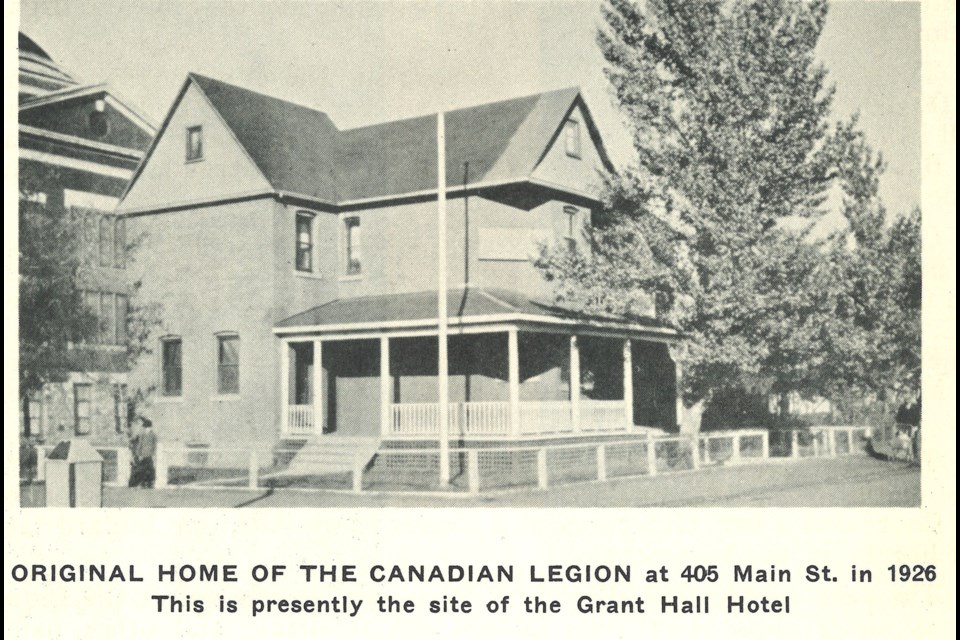MOOSE JAW — With Royal Canadian Legion Branch No. 59 moving in May to 693 Fairford Street West, here are some memorable moments from its time at its 268 High Street West location.
“We have been in this building for almost 98 years. It holds thousands of memories of great times and there have been challenges,” said Norma Richardson, the legion’s public relations officer. “We now have the opportunity to carry on to a much newer, but smaller, building and keep our branch active.”
Quoting the late Art Waters, secretary-manager from 1972 to 1976, Richardson added, “In all these ways, Moose Jaw Branch No. 59 of the Royal Canadian Legion has kept the ‘old torch’ burning and lit ‘new fires’ each year. May we long continue to do both.”
After the Great War
After the First World War concluded, many veterans joined the Great War Veterans Association of Canada, which was located at the fire hall on Saskatchewan Street.
In 1919, the organization purchased 406 Main Street West, where the Grant Hall Hotel is now. The building had bedrooms, while club rooms were where “the chief interest was the BEER,” according to legion records.
The Canadian Legion was formed in late 1925, and the branch received its charter on Oct. 16, 1926, while the Ladies Auxiliary received its charter a month later.
The new organization needed a bigger home to accommodate the growing membership, but an offer from the Community Hotel Association to buy the property brought mixed feelings. The offer nearly destroyed the organization, but the sellers finally won.
The association paid the branch $25,000 for the house and property, while the branch temporarily moved to the second floor of the old Market Building. This money, plus $5,000 in donations, helped construct the building at 268 High Street West.
After three days of celebrations, the legion’s new home officially opened on Nov. 11, 1927, at 2 p.m.
The late 1920s
The new building’s basement had a library, recreation rooms, storage, washrooms, and a checkroom. Heating was by coal, followed by oil and then gas.
The main floor had a spacious auditorium, a small kitchen, a checkroom and a secretary’s office. The second floor had rooms for permanent and transient residents and a caretaker’s suite.
The organization had trouble with its basement hardwood floor because when heavy rain came and the sewer cut-off was not closed, over a foot of water and residue filled the basement, documents show. When the floor dried, it warped and heaved.
The 1940s
In the early 1940s, the legion used its rooms for meetings, executive board activities, a ladies’ lounge, the caretaker’s suite and a night watchman’s quarters.
In 1946, the legion added to the building’s north side for extra space for games in the basement, plus a kitchen, a stage on the main floor, a cement basement floor, and new furniture. This cost $22,000, which the organization raised in 10 days after appealing to citizens.
The 1950s
In the 1950s, the legion spent roughly $40,000 for washrooms, floor coverings, décor, furnishings and a new electrical system. In 1959, provincial liquor legislation introduced licences for properly managed veterans’ clubs and organizations.
Meanwhile, the organization officially opened its Memorial Lounge on Oct. 21, 1960.
The 1960s
The legion made many improvements between 1960 and 1964, as it disposed of old furniture, renovated the kitchen and installed air conditioning. It also purchased a house on the east side for $8,000.
In 1965, the legion added to the building’s east side, which provided more auditorium space for dart boards and an office and lounge downstairs, along with auxiliary heating and air conditioning.
The cost was roughly $80,000, and the organization completed the project in February 1966. Meanwhile, the provincial mixed drinking law came into effect in 1968 and changed the atmosphere of the branch’s life, documents show.
The Flood
On April 18, 1974, the legion’s bingo was about to start, but water was seen coming from the west up High Street, so bingo players received back their money and were told to leave.
When they left, the water was over the curb and covered the sidewalk. Members moved all the documents from the basement office to the upstairs auditorium, while others moved the basement carpet, records show. Furthermore, the bar was closed and the power and gas were shut off.
Water was a foot deep when members left, and while High Street was flooded, it was dry two blocks north. The next day, when members returned, they found water almost to the top of the basement stairs, while chairs and tables were floating, along with cigarettes and empty bottles.
Everyone rallied to the cause, which helped the lounge reopen a month later.
1970s
In 1975, the legion completed a large maintenance project that included removing and blocking windows in the auditorium, painting the auditorium and lounge, retiling the washroom floors and repairing the original roof.
1980s
The legion installed an elevator and ramp in the mid-1980s, which involved extensive expansion of the front entrance of the original building.
1990s
From the 1990s into the 2000s, the legion continued with maintenance projects, new carpets, replacing the old Formica tabletops with wood and purchasing more houses on the east side to expand the parking lot.
In 2014, the organization renovated the kitchen, and in 2015, made extensive renovations to the building and auditorium, including a new roof, duct work, electrical, painting, and refinishing the wood dance floor.
The legion received $50,000 from the estate of Philip Hartley Heaton, a founding member and Life Member, so it renamed the auditorium the Philip Heaton Hall.
The pandemic
The COVID-19 pandemic hit in 2020 and legion business stopped. The aging building was expensive to maintain and the organization did not have the funds to carry on, so it sold the building to a Chinese realtor and signed a five-year lease to rent back the basement lounge.
Editor's note: Special thanks to the legion's Norma Richardson for providing some of this information.


.png;w=120;h=80;mode=crop)

